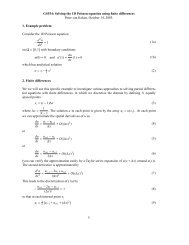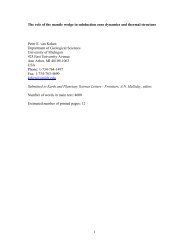Quantitative paleoenvironmental and paleoclimatic reconstruction ...
Quantitative paleoenvironmental and paleoclimatic reconstruction ...
Quantitative paleoenvironmental and paleoclimatic reconstruction ...
You also want an ePaper? Increase the reach of your titles
YUMPU automatically turns print PDFs into web optimized ePapers that Google loves.
ARTICLE IN PRESS<br />
6 N.D. Sheldon, N.J. Tabor / Earth-Science Reviews xxx (2009) xxx–xxx<br />
76% of original thickness given independent constraints on burial<br />
depth.<br />
The primary disadvantages to the approach of Sheldon <strong>and</strong><br />
Retallack (2001) are that it requires accurate soil taxonomy <strong>and</strong> that<br />
it requires a fairly accurate estimate of the burial overburden. Because<br />
the differences in compactibility among different soil orders can be<br />
fairly large (Fig. 4), accurate taxonomic identification is very<br />
important. Similarly, most of the compaction predicted by Eq. (4)<br />
occurs within burial depths of 4 km or less, with very little change<br />
among deeply buried paleosols. Thus, uncertainty in burial depth of<br />
even 500 m for shallowly buried paleosols would have a large effect on<br />
the calculated compaction.<br />
Fig. 4. Compactibility of different soil orders.<br />
To give one specific example, Retallack (1986) used ptygmatically<br />
folded clastic dikes in the ~2.2 Ga Hekpoort paleosol to estimate that it<br />
had been compacted to 67–73% of its original thickness. Sheldon <strong>and</strong><br />
Retallack (2001) used Eq. (4) <strong>and</strong> constants for a Vertisol (Retallack,<br />
1986; Driese et al., 2005) fromTable 2 to estimate compaction to 72–<br />
2.2.2. Ichnology<br />
A number of recent workers have begun integrating continental<br />
ichnology with studies of paleosols (e.g., Genise et al., 2004; Kirkl<strong>and</strong>,<br />
2006; Kraus <strong>and</strong> Hasiotis, 2006; Laza, 2006; Hamer et al., 2007a,b),<br />
<strong>and</strong> trace fossils have been key to underst<strong>and</strong>ing some early<br />
ecosystems (e.g., Feakes et al., 1989; Retallack <strong>and</strong> Feakes, 1987). A<br />
wide variety of animal <strong>and</strong> plant traces have been identified (e.g.,<br />
Hasiotis, 2004) that are useful in <strong>paleoenvironmental</strong> <strong>reconstruction</strong>s<br />
using paleosols. In particular, rhizolith or root trace density (Fig. 1D)<br />
<strong>and</strong> penetration depth have been used to underst<strong>and</strong> vegetation type<br />
<strong>and</strong> density (O'Geen <strong>and</strong> Busacca, 2001; Retallack, 2007) <strong>and</strong> to<br />
characterize the paleohydrological setting (Kraus <strong>and</strong> Hasiotis, 2006).<br />
In marine settings, a semi-quantitative ichnofabric index has been<br />
created (Droser <strong>and</strong> Bottjer, 1986) that looks at total bioturbation<br />
density. Attempts to apply this method to paleosols have been<br />
relatively rare <strong>and</strong> as Genise et al. (2004) point out, well-developed<br />
Fig. 5. Bioturbation index versus root size in paleosols. Data are from N.D. Sheldon <strong>and</strong> J.M.M. Hamer (unpublished). See text for discussion.<br />
Please cite this article as: Sheldon, N.D., Tabor, N.J., <strong>Quantitative</strong> <strong>paleoenvironmental</strong> <strong>and</strong> <strong>paleoclimatic</strong> <strong>reconstruction</strong> using paleosols, Earth-<br />
Science Reviews (2009), doi:10.1016/j.earscirev.2009.03.004















